Business Law Assignment: Enterprise Forms, Management, and Remedies
VerifiedAdded on 2023/01/06
|12
|3888
|52
Report
AI Summary
This report provides a comprehensive overview of business law, beginning with an introduction to its significance in corporate operations. The main body delves into the sources of law, differentiating between primary and secondary sources, and explaining the English legal system's foundations. It then explores the government's role in law-making, distinguishing between executive, legislative, and judiciary functions, and contrasts statutory and common law, using cases like R vs. Harris and Donoghue v Stevenson to illustrate legal procedures. Concrete examples are given to show the effect of copyright, employment, and contract laws on businesses. Various forms of business enterprises, including sole proprietorships and partnerships, and their legal creation are discussed. The report also covers corporate management and funding. Finally, it recommends legal remedies for business issues, using case studies to illustrate specific legal aspects. The conclusion summarizes the key findings and reinforces the importance of business law in ensuring efficient and legitimate operations.

Business Law
Paraphrase This Document
Need a fresh take? Get an instant paraphrase of this document with our AI Paraphraser
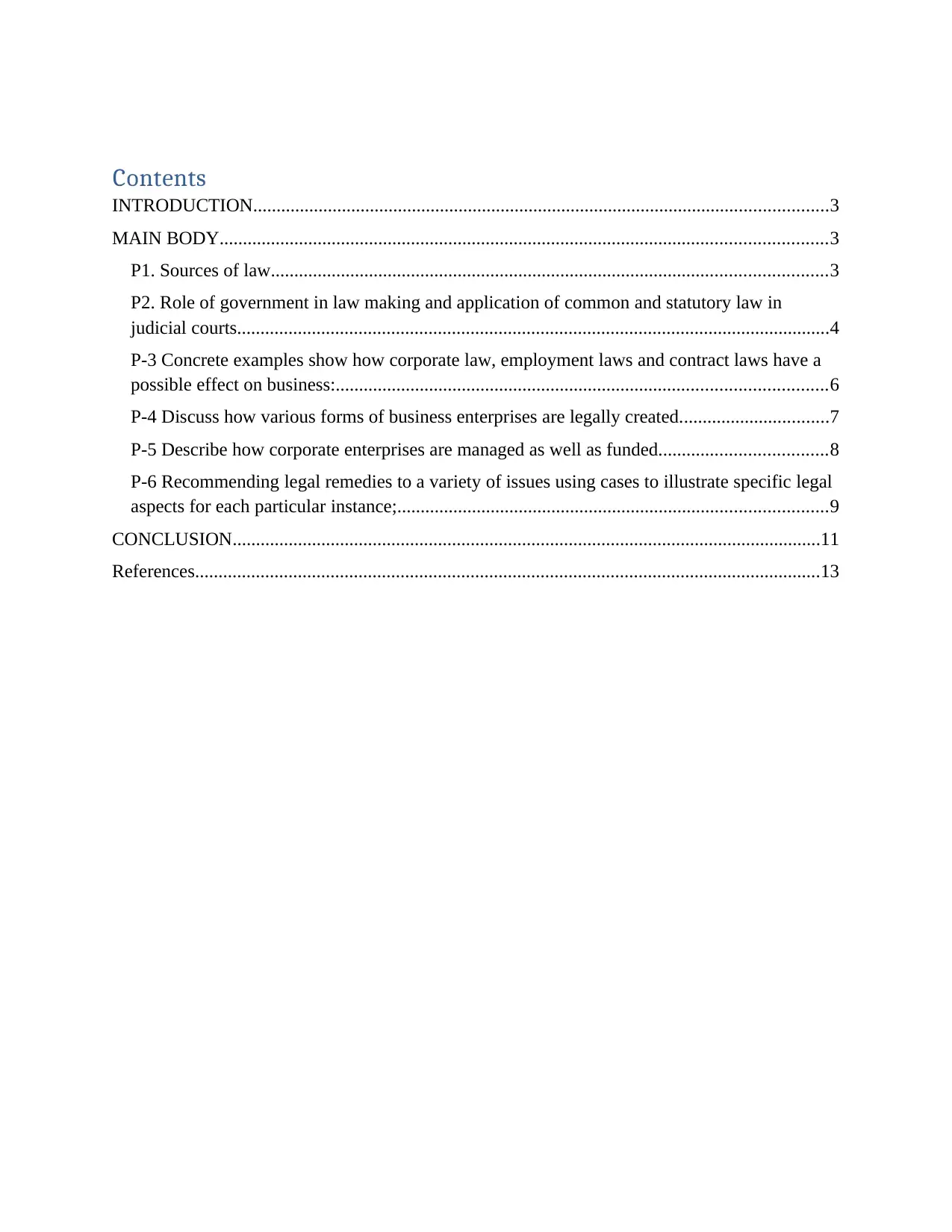
Contents
INTRODUCTION...........................................................................................................................3
MAIN BODY..................................................................................................................................3
P1. Sources of law.......................................................................................................................3
P2. Role of government in law making and application of common and statutory law in
judicial courts...............................................................................................................................4
P-3 Concrete examples show how corporate law, employment laws and contract laws have a
possible effect on business:.........................................................................................................6
P-4 Discuss how various forms of business enterprises are legally created................................7
P-5 Describe how corporate enterprises are managed as well as funded....................................8
P-6 Recommending legal remedies to a variety of issues using cases to illustrate specific legal
aspects for each particular instance;............................................................................................9
CONCLUSION..............................................................................................................................11
References......................................................................................................................................13
INTRODUCTION...........................................................................................................................3
MAIN BODY..................................................................................................................................3
P1. Sources of law.......................................................................................................................3
P2. Role of government in law making and application of common and statutory law in
judicial courts...............................................................................................................................4
P-3 Concrete examples show how corporate law, employment laws and contract laws have a
possible effect on business:.........................................................................................................6
P-4 Discuss how various forms of business enterprises are legally created................................7
P-5 Describe how corporate enterprises are managed as well as funded....................................8
P-6 Recommending legal remedies to a variety of issues using cases to illustrate specific legal
aspects for each particular instance;............................................................................................9
CONCLUSION..............................................................................................................................11
References......................................................................................................................................13
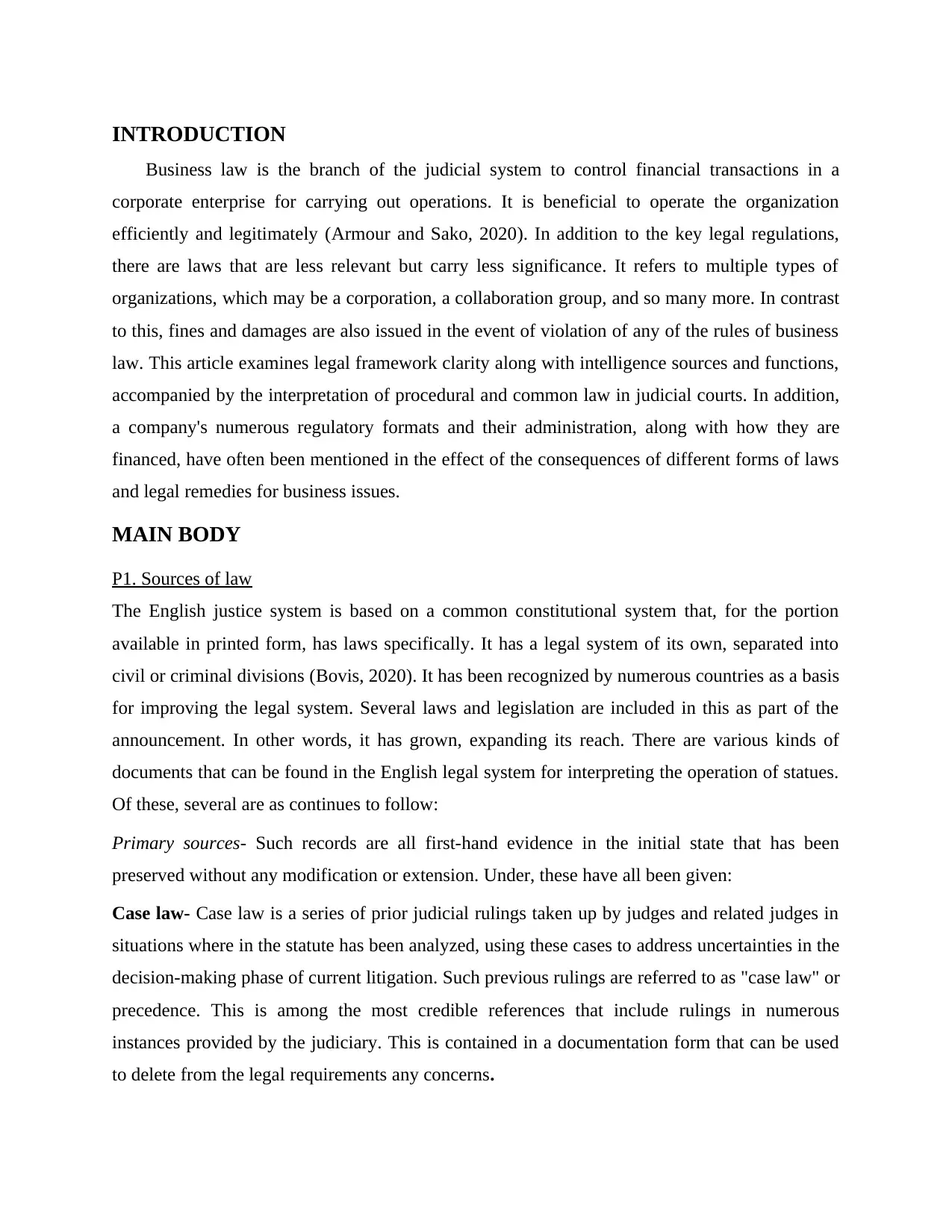
INTRODUCTION
Business law is the branch of the judicial system to control financial transactions in a
corporate enterprise for carrying out operations. It is beneficial to operate the organization
efficiently and legitimately (Armour and Sako, 2020). In addition to the key legal regulations,
there are laws that are less relevant but carry less significance. It refers to multiple types of
organizations, which may be a corporation, a collaboration group, and so many more. In contrast
to this, fines and damages are also issued in the event of violation of any of the rules of business
law. This article examines legal framework clarity along with intelligence sources and functions,
accompanied by the interpretation of procedural and common law in judicial courts. In addition,
a company's numerous regulatory formats and their administration, along with how they are
financed, have often been mentioned in the effect of the consequences of different forms of laws
and legal remedies for business issues.
MAIN BODY
P1. Sources of law
The English justice system is based on a common constitutional system that, for the portion
available in printed form, has laws specifically. It has a legal system of its own, separated into
civil or criminal divisions (Bovis, 2020). It has been recognized by numerous countries as a basis
for improving the legal system. Several laws and legislation are included in this as part of the
announcement. In other words, it has grown, expanding its reach. There are various kinds of
documents that can be found in the English legal system for interpreting the operation of statues.
Of these, several are as continues to follow:
Primary sources- Such records are all first-hand evidence in the initial state that has been
preserved without any modification or extension. Under, these have all been given:
Case law- Case law is a series of prior judicial rulings taken up by judges and related judges in
situations where in the statute has been analyzed, using these cases to address uncertainties in the
decision-making phase of current litigation. Such previous rulings are referred to as "case law" or
precedence. This is among the most credible references that include rulings in numerous
instances provided by the judiciary. This is contained in a documentation form that can be used
to delete from the legal requirements any concerns.
Business law is the branch of the judicial system to control financial transactions in a
corporate enterprise for carrying out operations. It is beneficial to operate the organization
efficiently and legitimately (Armour and Sako, 2020). In addition to the key legal regulations,
there are laws that are less relevant but carry less significance. It refers to multiple types of
organizations, which may be a corporation, a collaboration group, and so many more. In contrast
to this, fines and damages are also issued in the event of violation of any of the rules of business
law. This article examines legal framework clarity along with intelligence sources and functions,
accompanied by the interpretation of procedural and common law in judicial courts. In addition,
a company's numerous regulatory formats and their administration, along with how they are
financed, have often been mentioned in the effect of the consequences of different forms of laws
and legal remedies for business issues.
MAIN BODY
P1. Sources of law
The English justice system is based on a common constitutional system that, for the portion
available in printed form, has laws specifically. It has a legal system of its own, separated into
civil or criminal divisions (Bovis, 2020). It has been recognized by numerous countries as a basis
for improving the legal system. Several laws and legislation are included in this as part of the
announcement. In other words, it has grown, expanding its reach. There are various kinds of
documents that can be found in the English legal system for interpreting the operation of statues.
Of these, several are as continues to follow:
Primary sources- Such records are all first-hand evidence in the initial state that has been
preserved without any modification or extension. Under, these have all been given:
Case law- Case law is a series of prior judicial rulings taken up by judges and related judges in
situations where in the statute has been analyzed, using these cases to address uncertainties in the
decision-making phase of current litigation. Such previous rulings are referred to as "case law" or
precedence. This is among the most credible references that include rulings in numerous
instances provided by the judiciary. This is contained in a documentation form that can be used
to delete from the legal requirements any concerns.
⊘ This is a preview!⊘
Do you want full access?
Subscribe today to unlock all pages.

Trusted by 1+ million students worldwide
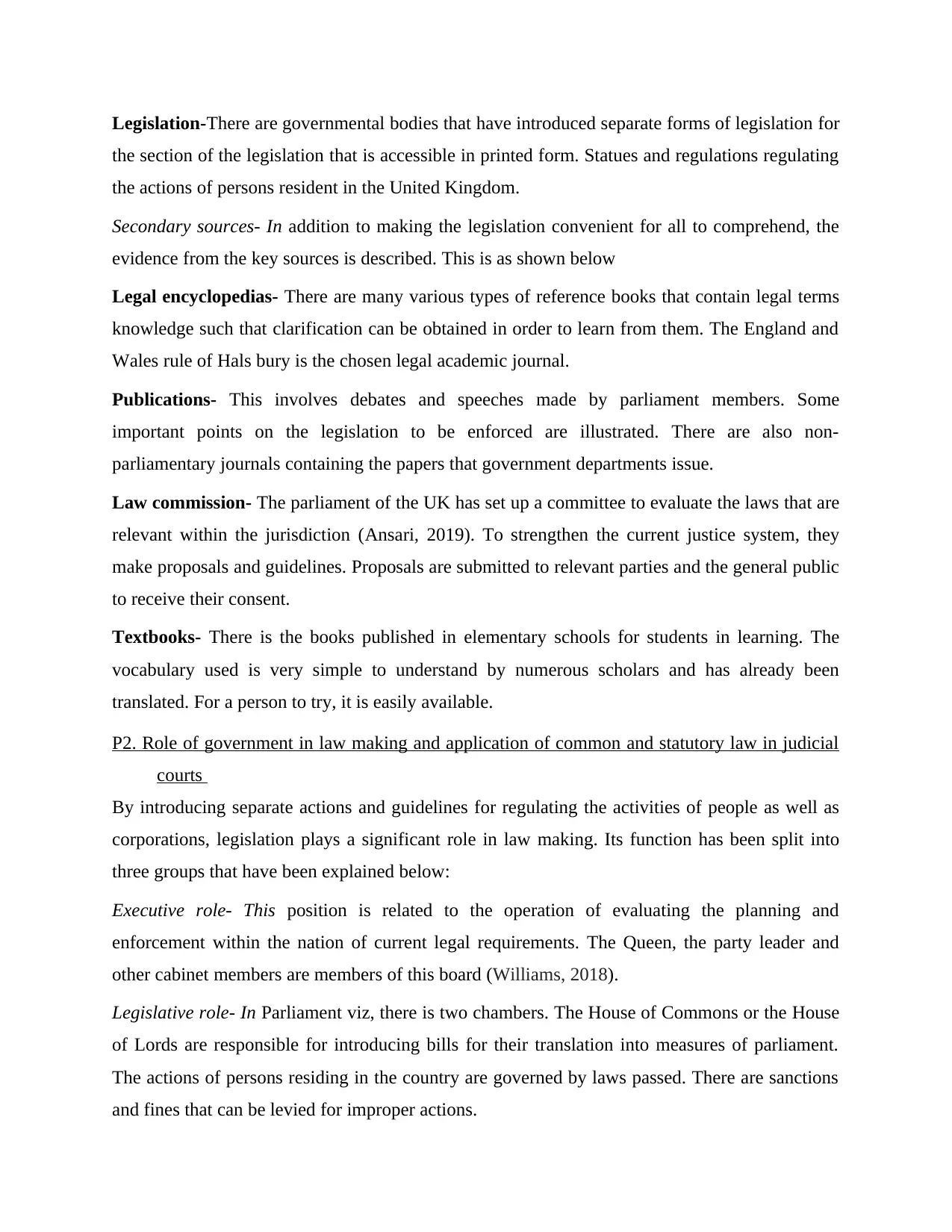
Legislation-There are governmental bodies that have introduced separate forms of legislation for
the section of the legislation that is accessible in printed form. Statues and regulations regulating
the actions of persons resident in the United Kingdom.
Secondary sources- In addition to making the legislation convenient for all to comprehend, the
evidence from the key sources is described. This is as shown below
Legal encyclopedias- There are many various types of reference books that contain legal terms
knowledge such that clarification can be obtained in order to learn from them. The England and
Wales rule of Hals bury is the chosen legal academic journal.
Publications- This involves debates and speeches made by parliament members. Some
important points on the legislation to be enforced are illustrated. There are also non-
parliamentary journals containing the papers that government departments issue.
Law commission- The parliament of the UK has set up a committee to evaluate the laws that are
relevant within the jurisdiction (Ansari, 2019). To strengthen the current justice system, they
make proposals and guidelines. Proposals are submitted to relevant parties and the general public
to receive their consent.
Textbooks- There is the books published in elementary schools for students in learning. The
vocabulary used is very simple to understand by numerous scholars and has already been
translated. For a person to try, it is easily available.
P2. Role of government in law making and application of common and statutory law in judicial
courts
By introducing separate actions and guidelines for regulating the activities of people as well as
corporations, legislation plays a significant role in law making. Its function has been split into
three groups that have been explained below:
Executive role- This position is related to the operation of evaluating the planning and
enforcement within the nation of current legal requirements. The Queen, the party leader and
other cabinet members are members of this board (Williams, 2018).
Legislative role- In Parliament viz, there is two chambers. The House of Commons or the House
of Lords are responsible for introducing bills for their translation into measures of parliament.
The actions of persons residing in the country are governed by laws passed. There are sanctions
and fines that can be levied for improper actions.
the section of the legislation that is accessible in printed form. Statues and regulations regulating
the actions of persons resident in the United Kingdom.
Secondary sources- In addition to making the legislation convenient for all to comprehend, the
evidence from the key sources is described. This is as shown below
Legal encyclopedias- There are many various types of reference books that contain legal terms
knowledge such that clarification can be obtained in order to learn from them. The England and
Wales rule of Hals bury is the chosen legal academic journal.
Publications- This involves debates and speeches made by parliament members. Some
important points on the legislation to be enforced are illustrated. There are also non-
parliamentary journals containing the papers that government departments issue.
Law commission- The parliament of the UK has set up a committee to evaluate the laws that are
relevant within the jurisdiction (Ansari, 2019). To strengthen the current justice system, they
make proposals and guidelines. Proposals are submitted to relevant parties and the general public
to receive their consent.
Textbooks- There is the books published in elementary schools for students in learning. The
vocabulary used is very simple to understand by numerous scholars and has already been
translated. For a person to try, it is easily available.
P2. Role of government in law making and application of common and statutory law in judicial
courts
By introducing separate actions and guidelines for regulating the activities of people as well as
corporations, legislation plays a significant role in law making. Its function has been split into
three groups that have been explained below:
Executive role- This position is related to the operation of evaluating the planning and
enforcement within the nation of current legal requirements. The Queen, the party leader and
other cabinet members are members of this board (Williams, 2018).
Legislative role- In Parliament viz, there is two chambers. The House of Commons or the House
of Lords are responsible for introducing bills for their translation into measures of parliament.
The actions of persons residing in the country are governed by laws passed. There are sanctions
and fines that can be levied for improper actions.
Paraphrase This Document
Need a fresh take? Get an instant paraphrase of this document with our AI Paraphraser
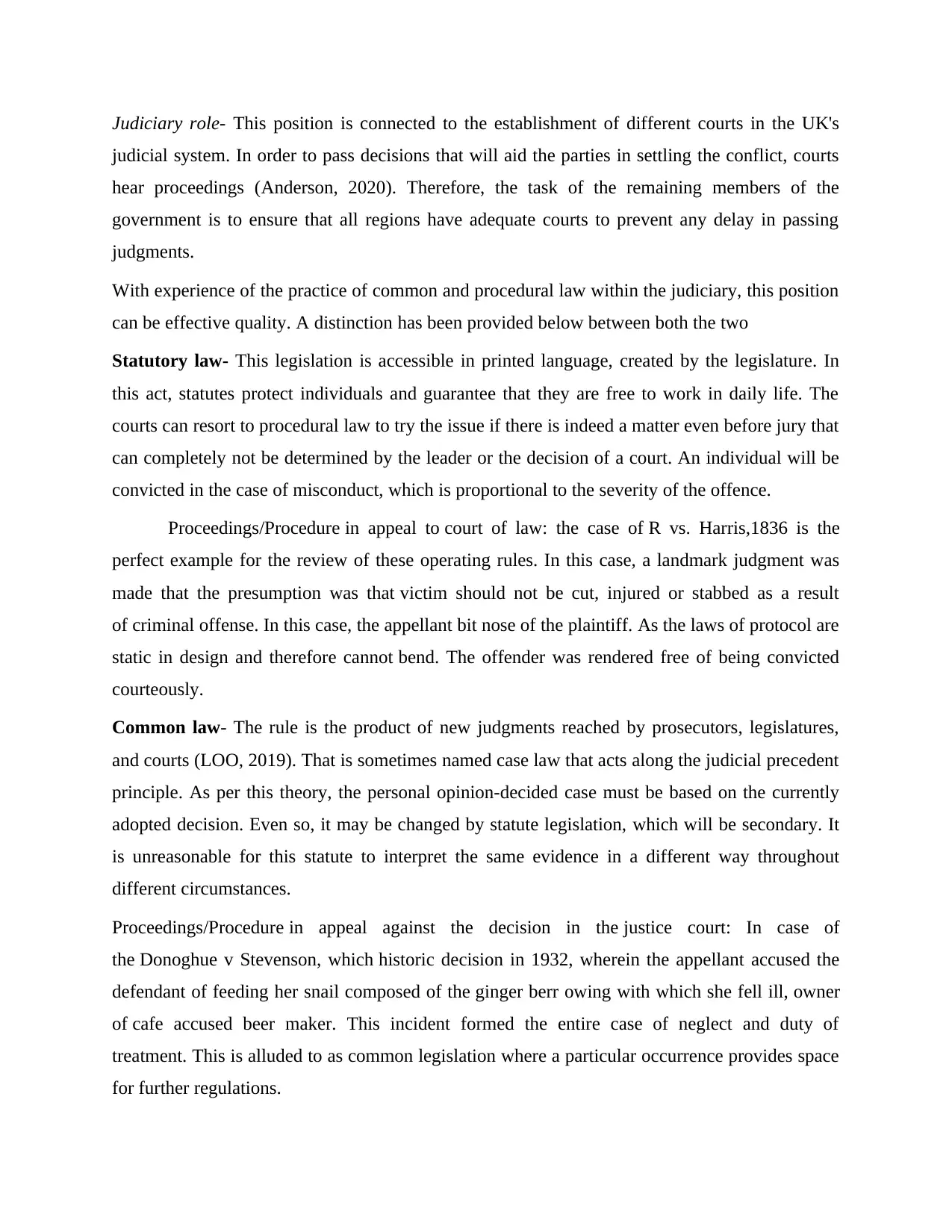
Judiciary role- This position is connected to the establishment of different courts in the UK's
judicial system. In order to pass decisions that will aid the parties in settling the conflict, courts
hear proceedings (Anderson, 2020). Therefore, the task of the remaining members of the
government is to ensure that all regions have adequate courts to prevent any delay in passing
judgments.
With experience of the practice of common and procedural law within the judiciary, this position
can be effective quality. A distinction has been provided below between both the two
Statutory law- This legislation is accessible in printed language, created by the legislature. In
this act, statutes protect individuals and guarantee that they are free to work in daily life. The
courts can resort to procedural law to try the issue if there is indeed a matter even before jury that
can completely not be determined by the leader or the decision of a court. An individual will be
convicted in the case of misconduct, which is proportional to the severity of the offence.
Proceedings/Procedure in appeal to court of law: the case of R vs. Harris,1836 is the
perfect example for the review of these operating rules. In this case, a landmark judgment was
made that the presumption was that victim should not be cut, injured or stabbed as a result
of criminal offense. In this case, the appellant bit nose of the plaintiff. As the laws of protocol are
static in design and therefore cannot bend. The offender was rendered free of being convicted
courteously.
Common law- The rule is the product of new judgments reached by prosecutors, legislatures,
and courts (LOO, 2019). That is sometimes named case law that acts along the judicial precedent
principle. As per this theory, the personal opinion-decided case must be based on the currently
adopted decision. Even so, it may be changed by statute legislation, which will be secondary. It
is unreasonable for this statute to interpret the same evidence in a different way throughout
different circumstances.
Proceedings/Procedure in appeal against the decision in the justice court: In case of
the Donoghue v Stevenson, which historic decision in 1932, wherein the appellant accused the
defendant of feeding her snail composed of the ginger berr owing with which she fell ill, owner
of cafe accused beer maker. This incident formed the entire case of neglect and duty of
treatment. This is alluded to as common legislation where a particular occurrence provides space
for further regulations.
judicial system. In order to pass decisions that will aid the parties in settling the conflict, courts
hear proceedings (Anderson, 2020). Therefore, the task of the remaining members of the
government is to ensure that all regions have adequate courts to prevent any delay in passing
judgments.
With experience of the practice of common and procedural law within the judiciary, this position
can be effective quality. A distinction has been provided below between both the two
Statutory law- This legislation is accessible in printed language, created by the legislature. In
this act, statutes protect individuals and guarantee that they are free to work in daily life. The
courts can resort to procedural law to try the issue if there is indeed a matter even before jury that
can completely not be determined by the leader or the decision of a court. An individual will be
convicted in the case of misconduct, which is proportional to the severity of the offence.
Proceedings/Procedure in appeal to court of law: the case of R vs. Harris,1836 is the
perfect example for the review of these operating rules. In this case, a landmark judgment was
made that the presumption was that victim should not be cut, injured or stabbed as a result
of criminal offense. In this case, the appellant bit nose of the plaintiff. As the laws of protocol are
static in design and therefore cannot bend. The offender was rendered free of being convicted
courteously.
Common law- The rule is the product of new judgments reached by prosecutors, legislatures,
and courts (LOO, 2019). That is sometimes named case law that acts along the judicial precedent
principle. As per this theory, the personal opinion-decided case must be based on the currently
adopted decision. Even so, it may be changed by statute legislation, which will be secondary. It
is unreasonable for this statute to interpret the same evidence in a different way throughout
different circumstances.
Proceedings/Procedure in appeal against the decision in the justice court: In case of
the Donoghue v Stevenson, which historic decision in 1932, wherein the appellant accused the
defendant of feeding her snail composed of the ginger berr owing with which she fell ill, owner
of cafe accused beer maker. This incident formed the entire case of neglect and duty of
treatment. This is alluded to as common legislation where a particular occurrence provides space
for further regulations.
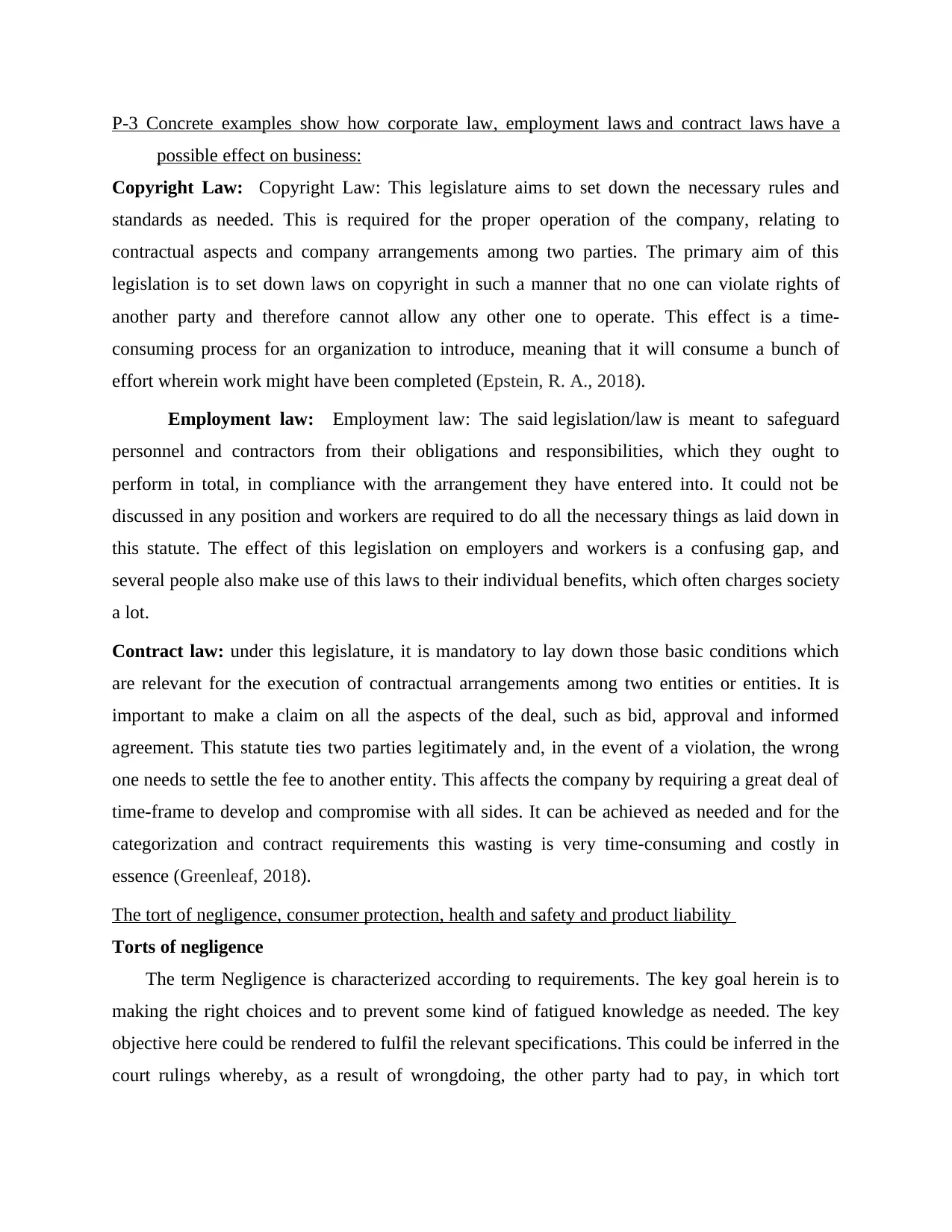
P-3 Concrete examples show how corporate law, employment laws and contract laws have a
possible effect on business:
Copyright Law: Copyright Law: This legislature aims to set down the necessary rules and
standards as needed. This is required for the proper operation of the company, relating to
contractual aspects and company arrangements among two parties. The primary aim of this
legislation is to set down laws on copyright in such a manner that no one can violate rights of
another party and therefore cannot allow any other one to operate. This effect is a time-
consuming process for an organization to introduce, meaning that it will consume a bunch of
effort wherein work might have been completed (Epstein, R. A., 2018).
Employment law: Employment law: The said legislation/law is meant to safeguard
personnel and contractors from their obligations and responsibilities, which they ought to
perform in total, in compliance with the arrangement they have entered into. It could not be
discussed in any position and workers are required to do all the necessary things as laid down in
this statute. The effect of this legislation on employers and workers is a confusing gap, and
several people also make use of this laws to their individual benefits, which often charges society
a lot.
Contract law: under this legislature, it is mandatory to lay down those basic conditions which
are relevant for the execution of contractual arrangements among two entities or entities. It is
important to make a claim on all the aspects of the deal, such as bid, approval and informed
agreement. This statute ties two parties legitimately and, in the event of a violation, the wrong
one needs to settle the fee to another entity. This affects the company by requiring a great deal of
time-frame to develop and compromise with all sides. It can be achieved as needed and for the
categorization and contract requirements this wasting is very time-consuming and costly in
essence (Greenleaf, 2018).
The tort of negligence, consumer protection, health and safety and product liability
Torts of negligence
The term Negligence is characterized according to requirements. The key goal herein is to
making the right choices and to prevent some kind of fatigued knowledge as needed. The key
objective here could be rendered to fulfil the relevant specifications. This could be inferred in the
court rulings whereby, as a result of wrongdoing, the other party had to pay, in which tort
possible effect on business:
Copyright Law: Copyright Law: This legislature aims to set down the necessary rules and
standards as needed. This is required for the proper operation of the company, relating to
contractual aspects and company arrangements among two parties. The primary aim of this
legislation is to set down laws on copyright in such a manner that no one can violate rights of
another party and therefore cannot allow any other one to operate. This effect is a time-
consuming process for an organization to introduce, meaning that it will consume a bunch of
effort wherein work might have been completed (Epstein, R. A., 2018).
Employment law: Employment law: The said legislation/law is meant to safeguard
personnel and contractors from their obligations and responsibilities, which they ought to
perform in total, in compliance with the arrangement they have entered into. It could not be
discussed in any position and workers are required to do all the necessary things as laid down in
this statute. The effect of this legislation on employers and workers is a confusing gap, and
several people also make use of this laws to their individual benefits, which often charges society
a lot.
Contract law: under this legislature, it is mandatory to lay down those basic conditions which
are relevant for the execution of contractual arrangements among two entities or entities. It is
important to make a claim on all the aspects of the deal, such as bid, approval and informed
agreement. This statute ties two parties legitimately and, in the event of a violation, the wrong
one needs to settle the fee to another entity. This affects the company by requiring a great deal of
time-frame to develop and compromise with all sides. It can be achieved as needed and for the
categorization and contract requirements this wasting is very time-consuming and costly in
essence (Greenleaf, 2018).
The tort of negligence, consumer protection, health and safety and product liability
Torts of negligence
The term Negligence is characterized according to requirements. The key goal herein is to
making the right choices and to prevent some kind of fatigued knowledge as needed. The key
objective here could be rendered to fulfil the relevant specifications. This could be inferred in the
court rulings whereby, as a result of wrongdoing, the other party had to pay, in which tort
⊘ This is a preview!⊘
Do you want full access?
Subscribe today to unlock all pages.

Trusted by 1+ million students worldwide
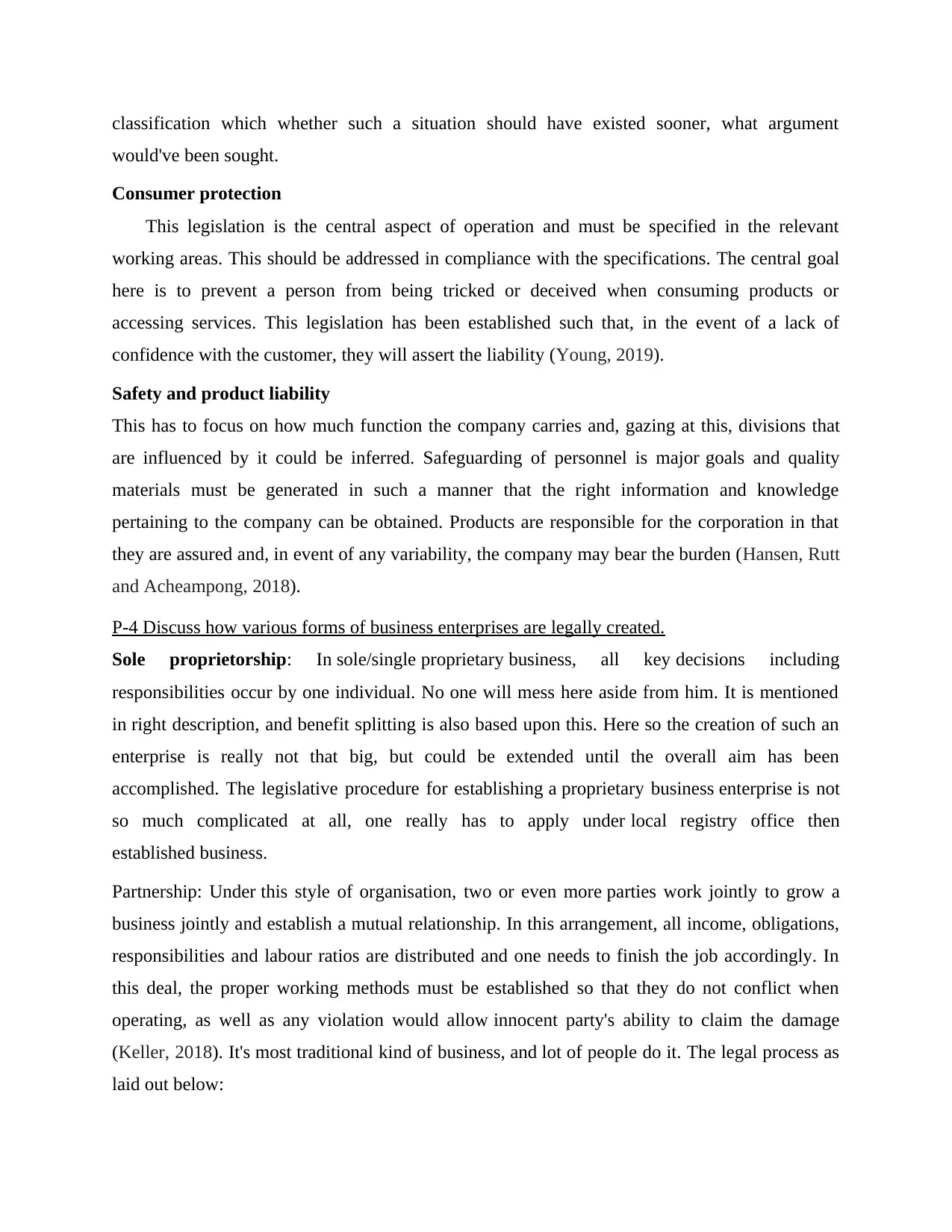
classification which whether such a situation should have existed sooner, what argument
would've been sought.
Consumer protection
This legislation is the central aspect of operation and must be specified in the relevant
working areas. This should be addressed in compliance with the specifications. The central goal
here is to prevent a person from being tricked or deceived when consuming products or
accessing services. This legislation has been established such that, in the event of a lack of
confidence with the customer, they will assert the liability (Young, 2019).
Safety and product liability
This has to focus on how much function the company carries and, gazing at this, divisions that
are influenced by it could be inferred. Safeguarding of personnel is major goals and quality
materials must be generated in such a manner that the right information and knowledge
pertaining to the company can be obtained. Products are responsible for the corporation in that
they are assured and, in event of any variability, the company may bear the burden (Hansen, Rutt
and Acheampong, 2018).
P-4 Discuss how various forms of business enterprises are legally created.
Sole proprietorship: In sole/single proprietary business, all key decisions including
responsibilities occur by one individual. No one will mess here aside from him. It is mentioned
in right description, and benefit splitting is also based upon this. Here so the creation of such an
enterprise is really not that big, but could be extended until the overall aim has been
accomplished. The legislative procedure for establishing a proprietary business enterprise is not
so much complicated at all, one really has to apply under local registry office then
established business.
Partnership: Under this style of organisation, two or even more parties work jointly to grow a
business jointly and establish a mutual relationship. In this arrangement, all income, obligations,
responsibilities and labour ratios are distributed and one needs to finish the job accordingly. In
this deal, the proper working methods must be established so that they do not conflict when
operating, as well as any violation would allow innocent party's ability to claim the damage
(Keller, 2018). It's most traditional kind of business, and lot of people do it. The legal process as
laid out below:
would've been sought.
Consumer protection
This legislation is the central aspect of operation and must be specified in the relevant
working areas. This should be addressed in compliance with the specifications. The central goal
here is to prevent a person from being tricked or deceived when consuming products or
accessing services. This legislation has been established such that, in the event of a lack of
confidence with the customer, they will assert the liability (Young, 2019).
Safety and product liability
This has to focus on how much function the company carries and, gazing at this, divisions that
are influenced by it could be inferred. Safeguarding of personnel is major goals and quality
materials must be generated in such a manner that the right information and knowledge
pertaining to the company can be obtained. Products are responsible for the corporation in that
they are assured and, in event of any variability, the company may bear the burden (Hansen, Rutt
and Acheampong, 2018).
P-4 Discuss how various forms of business enterprises are legally created.
Sole proprietorship: In sole/single proprietary business, all key decisions including
responsibilities occur by one individual. No one will mess here aside from him. It is mentioned
in right description, and benefit splitting is also based upon this. Here so the creation of such an
enterprise is really not that big, but could be extended until the overall aim has been
accomplished. The legislative procedure for establishing a proprietary business enterprise is not
so much complicated at all, one really has to apply under local registry office then
established business.
Partnership: Under this style of organisation, two or even more parties work jointly to grow a
business jointly and establish a mutual relationship. In this arrangement, all income, obligations,
responsibilities and labour ratios are distributed and one needs to finish the job accordingly. In
this deal, the proper working methods must be established so that they do not conflict when
operating, as well as any violation would allow innocent party's ability to claim the damage
(Keller, 2018). It's most traditional kind of business, and lot of people do it. The legal process as
laid out below:
Paraphrase This Document
Need a fresh take? Get an instant paraphrase of this document with our AI Paraphraser
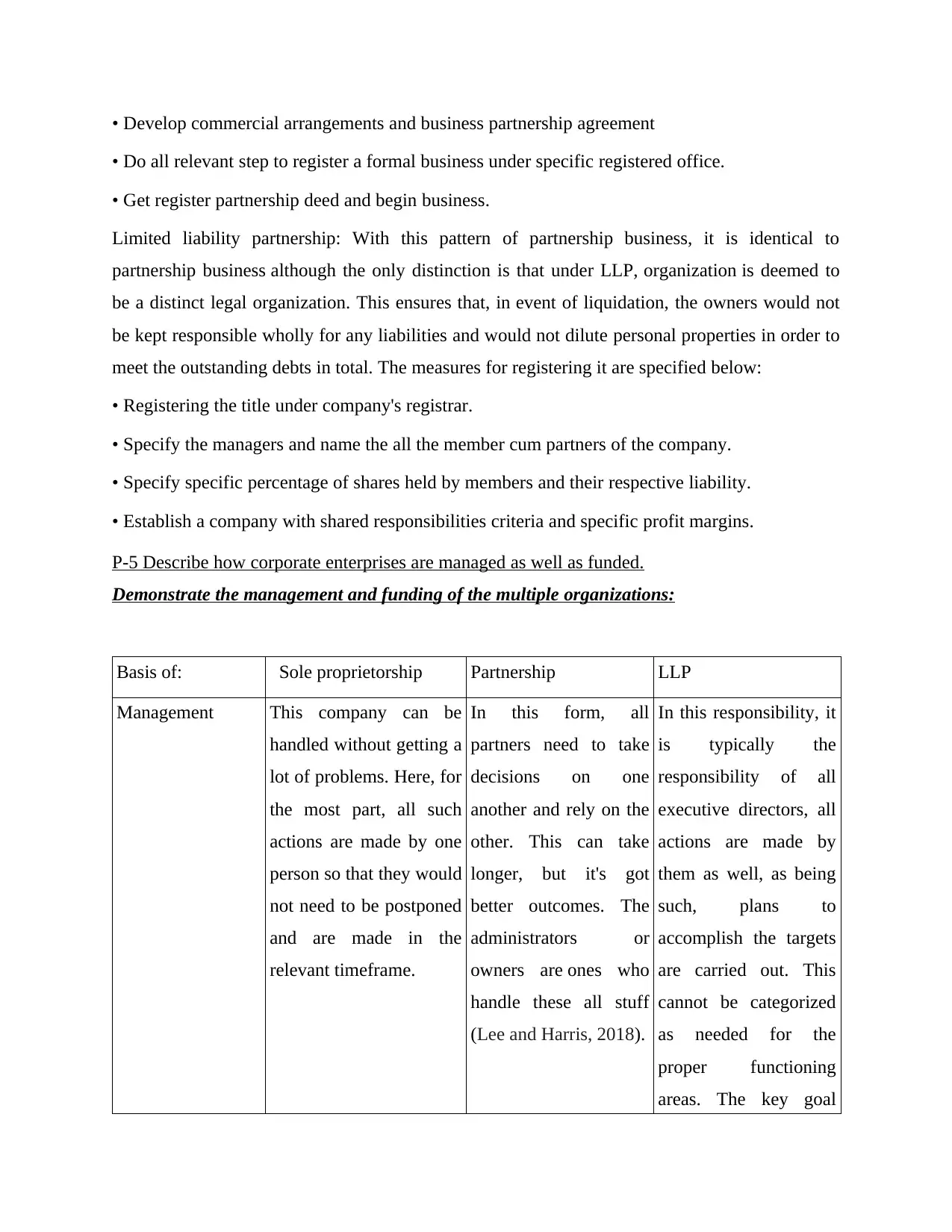
• Develop commercial arrangements and business partnership agreement
• Do all relevant step to register a formal business under specific registered office.
• Get register partnership deed and begin business.
Limited liability partnership: With this pattern of partnership business, it is identical to
partnership business although the only distinction is that under LLP, organization is deemed to
be a distinct legal organization. This ensures that, in event of liquidation, the owners would not
be kept responsible wholly for any liabilities and would not dilute personal properties in order to
meet the outstanding debts in total. The measures for registering it are specified below:
• Registering the title under company's registrar.
• Specify the managers and name the all the member cum partners of the company.
• Specify specific percentage of shares held by members and their respective liability.
• Establish a company with shared responsibilities criteria and specific profit margins.
P-5 Describe how corporate enterprises are managed as well as funded.
Demonstrate the management and funding of the multiple organizations:
Basis of: Sole proprietorship Partnership LLP
Management This company can be
handled without getting a
lot of problems. Here, for
the most part, all such
actions are made by one
person so that they would
not need to be postponed
and are made in the
relevant timeframe.
In this form, all
partners need to take
decisions on one
another and rely on the
other. This can take
longer, but it's got
better outcomes. The
administrators or
owners are ones who
handle these all stuff
(Lee and Harris, 2018).
In this responsibility, it
is typically the
responsibility of all
executive directors, all
actions are made by
them as well, as being
such, plans to
accomplish the targets
are carried out. This
cannot be categorized
as needed for the
proper functioning
areas. The key goal
• Do all relevant step to register a formal business under specific registered office.
• Get register partnership deed and begin business.
Limited liability partnership: With this pattern of partnership business, it is identical to
partnership business although the only distinction is that under LLP, organization is deemed to
be a distinct legal organization. This ensures that, in event of liquidation, the owners would not
be kept responsible wholly for any liabilities and would not dilute personal properties in order to
meet the outstanding debts in total. The measures for registering it are specified below:
• Registering the title under company's registrar.
• Specify the managers and name the all the member cum partners of the company.
• Specify specific percentage of shares held by members and their respective liability.
• Establish a company with shared responsibilities criteria and specific profit margins.
P-5 Describe how corporate enterprises are managed as well as funded.
Demonstrate the management and funding of the multiple organizations:
Basis of: Sole proprietorship Partnership LLP
Management This company can be
handled without getting a
lot of problems. Here, for
the most part, all such
actions are made by one
person so that they would
not need to be postponed
and are made in the
relevant timeframe.
In this form, all
partners need to take
decisions on one
another and rely on the
other. This can take
longer, but it's got
better outcomes. The
administrators or
owners are ones who
handle these all stuff
(Lee and Harris, 2018).
In this responsibility, it
is typically the
responsibility of all
executive directors, all
actions are made by
them as well, as being
such, plans to
accomplish the targets
are carried out. This
cannot be categorized
as needed for the
proper functioning
areas. The key goal
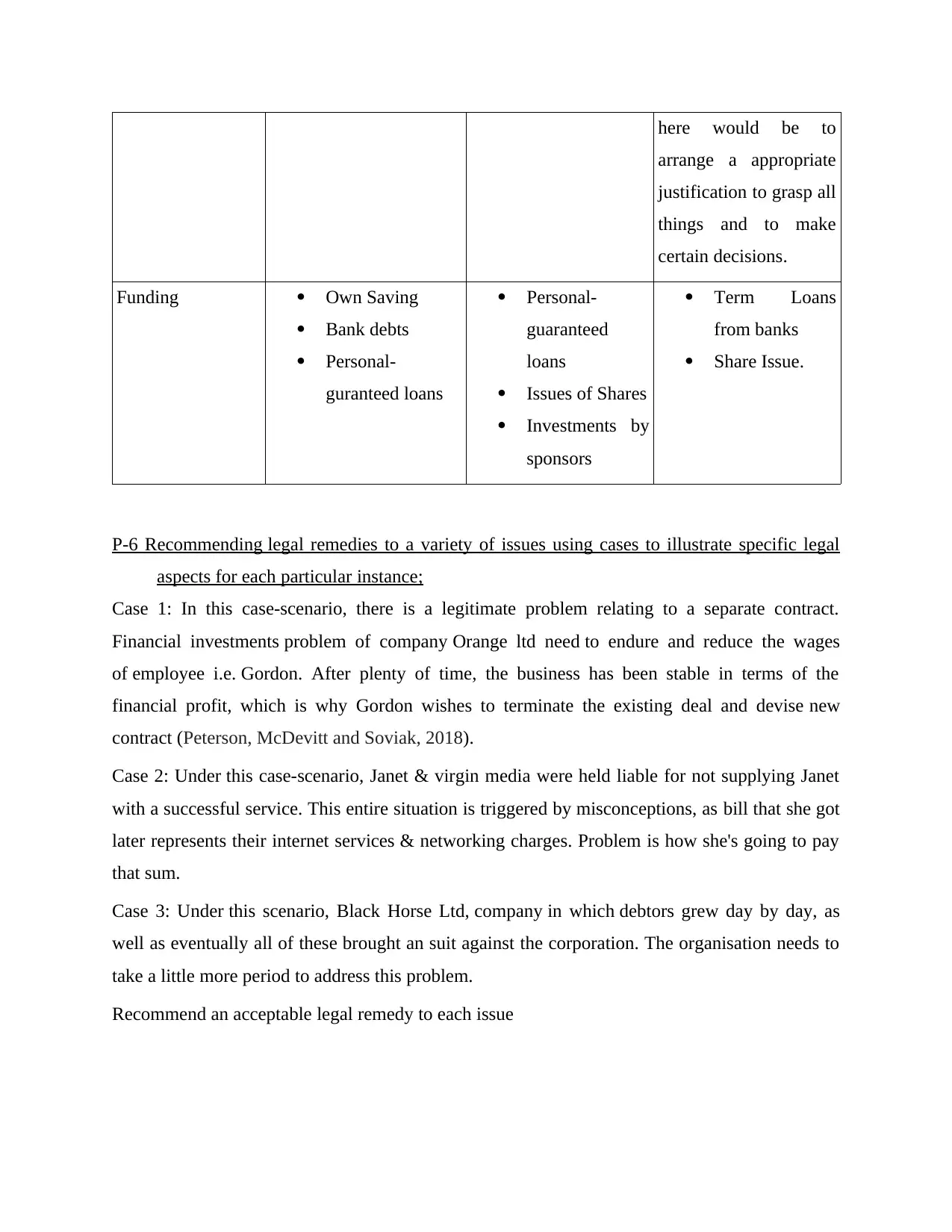
here would be to
arrange a appropriate
justification to grasp all
things and to make
certain decisions.
Funding Own Saving
Bank debts
Personal-
guranteed loans
Personal-
guaranteed
loans
Issues of Shares
Investments by
sponsors
Term Loans
from banks
Share Issue.
P-6 Recommending legal remedies to a variety of issues using cases to illustrate specific legal
aspects for each particular instance;
Case 1: In this case-scenario, there is a legitimate problem relating to a separate contract.
Financial investments problem of company Orange ltd need to endure and reduce the wages
of employee i.e. Gordon. After plenty of time, the business has been stable in terms of the
financial profit, which is why Gordon wishes to terminate the existing deal and devise new
contract (Peterson, McDevitt and Soviak, 2018).
Case 2: Under this case-scenario, Janet & virgin media were held liable for not supplying Janet
with a successful service. This entire situation is triggered by misconceptions, as bill that she got
later represents their internet services & networking charges. Problem is how she's going to pay
that sum.
Case 3: Under this scenario, Black Horse Ltd, company in which debtors grew day by day, as
well as eventually all of these brought an suit against the corporation. The organisation needs to
take a little more period to address this problem.
Recommend an acceptable legal remedy to each issue
arrange a appropriate
justification to grasp all
things and to make
certain decisions.
Funding Own Saving
Bank debts
Personal-
guranteed loans
Personal-
guaranteed
loans
Issues of Shares
Investments by
sponsors
Term Loans
from banks
Share Issue.
P-6 Recommending legal remedies to a variety of issues using cases to illustrate specific legal
aspects for each particular instance;
Case 1: In this case-scenario, there is a legitimate problem relating to a separate contract.
Financial investments problem of company Orange ltd need to endure and reduce the wages
of employee i.e. Gordon. After plenty of time, the business has been stable in terms of the
financial profit, which is why Gordon wishes to terminate the existing deal and devise new
contract (Peterson, McDevitt and Soviak, 2018).
Case 2: Under this case-scenario, Janet & virgin media were held liable for not supplying Janet
with a successful service. This entire situation is triggered by misconceptions, as bill that she got
later represents their internet services & networking charges. Problem is how she's going to pay
that sum.
Case 3: Under this scenario, Black Horse Ltd, company in which debtors grew day by day, as
well as eventually all of these brought an suit against the corporation. The organisation needs to
take a little more period to address this problem.
Recommend an acceptable legal remedy to each issue
⊘ This is a preview!⊘
Do you want full access?
Subscribe today to unlock all pages.

Trusted by 1+ million students worldwide
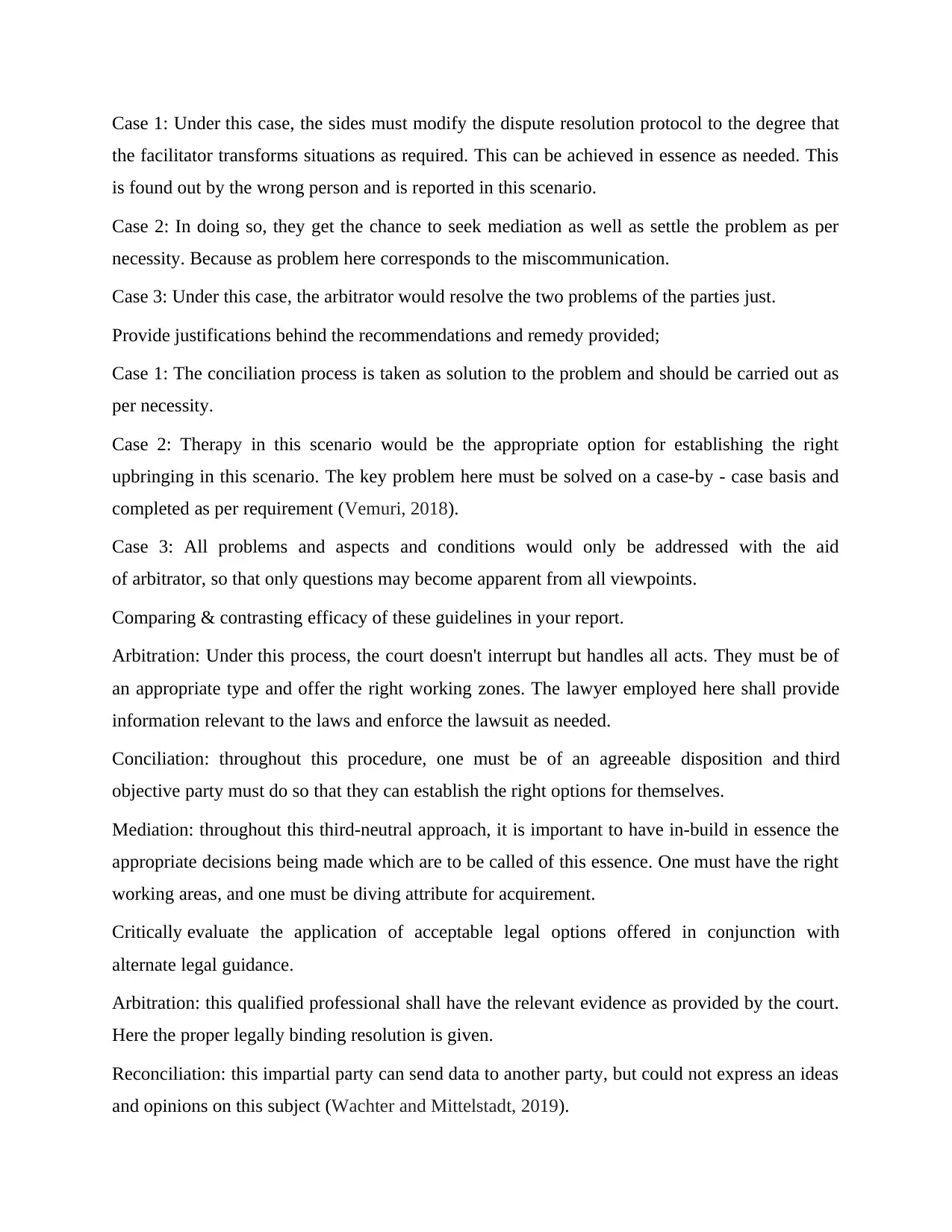
Case 1: Under this case, the sides must modify the dispute resolution protocol to the degree that
the facilitator transforms situations as required. This can be achieved in essence as needed. This
is found out by the wrong person and is reported in this scenario.
Case 2: In doing so, they get the chance to seek mediation as well as settle the problem as per
necessity. Because as problem here corresponds to the miscommunication.
Case 3: Under this case, the arbitrator would resolve the two problems of the parties just.
Provide justifications behind the recommendations and remedy provided;
Case 1: The conciliation process is taken as solution to the problem and should be carried out as
per necessity.
Case 2: Therapy in this scenario would be the appropriate option for establishing the right
upbringing in this scenario. The key problem here must be solved on a case-by - case basis and
completed as per requirement (Vemuri, 2018).
Case 3: All problems and aspects and conditions would only be addressed with the aid
of arbitrator, so that only questions may become apparent from all viewpoints.
Comparing & contrasting efficacy of these guidelines in your report.
Arbitration: Under this process, the court doesn't interrupt but handles all acts. They must be of
an appropriate type and offer the right working zones. The lawyer employed here shall provide
information relevant to the laws and enforce the lawsuit as needed.
Conciliation: throughout this procedure, one must be of an agreeable disposition and third
objective party must do so that they can establish the right options for themselves.
Mediation: throughout this third-neutral approach, it is important to have in-build in essence the
appropriate decisions being made which are to be called of this essence. One must have the right
working areas, and one must be diving attribute for acquirement.
Critically evaluate the application of acceptable legal options offered in conjunction with
alternate legal guidance.
Arbitration: this qualified professional shall have the relevant evidence as provided by the court.
Here the proper legally binding resolution is given.
Reconciliation: this impartial party can send data to another party, but could not express an ideas
and opinions on this subject (Wachter and Mittelstadt, 2019).
the facilitator transforms situations as required. This can be achieved in essence as needed. This
is found out by the wrong person and is reported in this scenario.
Case 2: In doing so, they get the chance to seek mediation as well as settle the problem as per
necessity. Because as problem here corresponds to the miscommunication.
Case 3: Under this case, the arbitrator would resolve the two problems of the parties just.
Provide justifications behind the recommendations and remedy provided;
Case 1: The conciliation process is taken as solution to the problem and should be carried out as
per necessity.
Case 2: Therapy in this scenario would be the appropriate option for establishing the right
upbringing in this scenario. The key problem here must be solved on a case-by - case basis and
completed as per requirement (Vemuri, 2018).
Case 3: All problems and aspects and conditions would only be addressed with the aid
of arbitrator, so that only questions may become apparent from all viewpoints.
Comparing & contrasting efficacy of these guidelines in your report.
Arbitration: Under this process, the court doesn't interrupt but handles all acts. They must be of
an appropriate type and offer the right working zones. The lawyer employed here shall provide
information relevant to the laws and enforce the lawsuit as needed.
Conciliation: throughout this procedure, one must be of an agreeable disposition and third
objective party must do so that they can establish the right options for themselves.
Mediation: throughout this third-neutral approach, it is important to have in-build in essence the
appropriate decisions being made which are to be called of this essence. One must have the right
working areas, and one must be diving attribute for acquirement.
Critically evaluate the application of acceptable legal options offered in conjunction with
alternate legal guidance.
Arbitration: this qualified professional shall have the relevant evidence as provided by the court.
Here the proper legally binding resolution is given.
Reconciliation: this impartial party can send data to another party, but could not express an ideas
and opinions on this subject (Wachter and Mittelstadt, 2019).
Paraphrase This Document
Need a fresh take? Get an instant paraphrase of this document with our AI Paraphraser
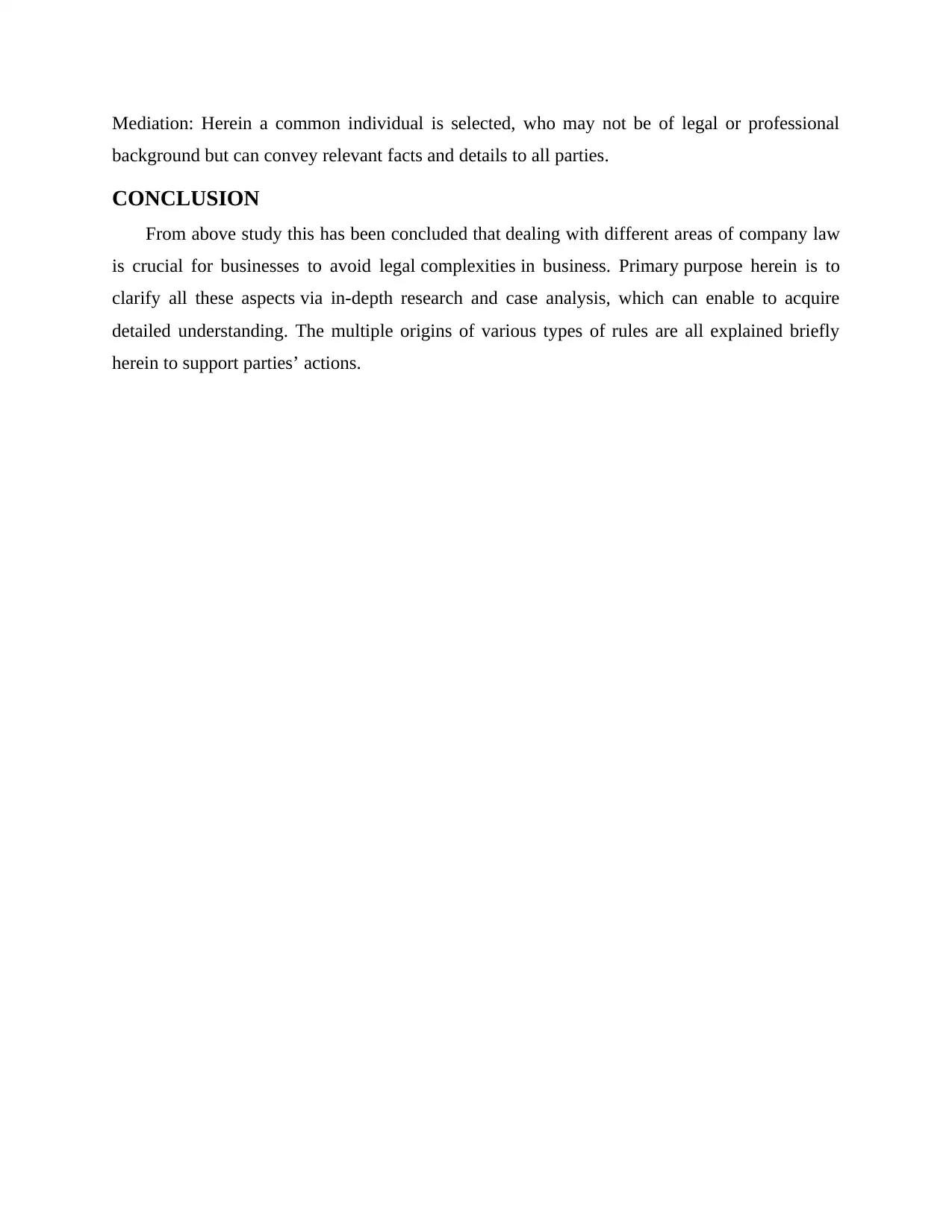
Mediation: Herein a common individual is selected, who may not be of legal or professional
background but can convey relevant facts and details to all parties.
CONCLUSION
From above study this has been concluded that dealing with different areas of company law
is crucial for businesses to avoid legal complexities in business. Primary purpose herein is to
clarify all these aspects via in-depth research and case analysis, which can enable to acquire
detailed understanding. The multiple origins of various types of rules are all explained briefly
herein to support parties’ actions.
background but can convey relevant facts and details to all parties.
CONCLUSION
From above study this has been concluded that dealing with different areas of company law
is crucial for businesses to avoid legal complexities in business. Primary purpose herein is to
clarify all these aspects via in-depth research and case analysis, which can enable to acquire
detailed understanding. The multiple origins of various types of rules are all explained briefly
herein to support parties’ actions.
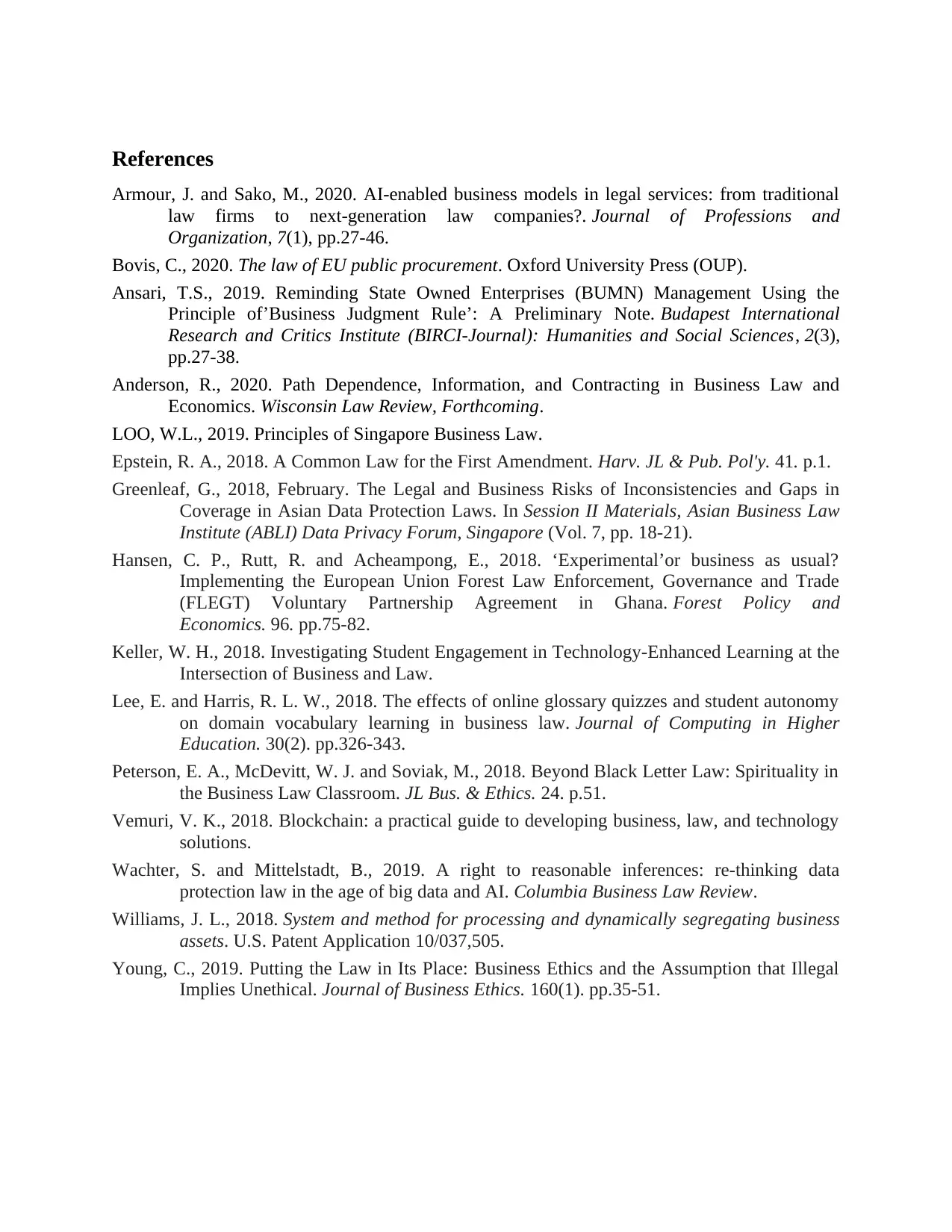
References
Armour, J. and Sako, M., 2020. AI-enabled business models in legal services: from traditional
law firms to next-generation law companies?. Journal of Professions and
Organization, 7(1), pp.27-46.
Bovis, C., 2020. The law of EU public procurement. Oxford University Press (OUP).
Ansari, T.S., 2019. Reminding State Owned Enterprises (BUMN) Management Using the
Principle of’Business Judgment Rule’: A Preliminary Note. Budapest International
Research and Critics Institute (BIRCI-Journal): Humanities and Social Sciences, 2(3),
pp.27-38.
Anderson, R., 2020. Path Dependence, Information, and Contracting in Business Law and
Economics. Wisconsin Law Review, Forthcoming.
LOO, W.L., 2019. Principles of Singapore Business Law.
Epstein, R. A., 2018. A Common Law for the First Amendment. Harv. JL & Pub. Pol'y. 41. p.1.
Greenleaf, G., 2018, February. The Legal and Business Risks of Inconsistencies and Gaps in
Coverage in Asian Data Protection Laws. In Session II Materials, Asian Business Law
Institute (ABLI) Data Privacy Forum, Singapore (Vol. 7, pp. 18-21).
Hansen, C. P., Rutt, R. and Acheampong, E., 2018. ‘Experimental’or business as usual?
Implementing the European Union Forest Law Enforcement, Governance and Trade
(FLEGT) Voluntary Partnership Agreement in Ghana. Forest Policy and
Economics. 96. pp.75-82.
Keller, W. H., 2018. Investigating Student Engagement in Technology-Enhanced Learning at the
Intersection of Business and Law.
Lee, E. and Harris, R. L. W., 2018. The effects of online glossary quizzes and student autonomy
on domain vocabulary learning in business law. Journal of Computing in Higher
Education. 30(2). pp.326-343.
Peterson, E. A., McDevitt, W. J. and Soviak, M., 2018. Beyond Black Letter Law: Spirituality in
the Business Law Classroom. JL Bus. & Ethics. 24. p.51.
Vemuri, V. K., 2018. Blockchain: a practical guide to developing business, law, and technology
solutions.
Wachter, S. and Mittelstadt, B., 2019. A right to reasonable inferences: re-thinking data
protection law in the age of big data and AI. Columbia Business Law Review.
Williams, J. L., 2018. System and method for processing and dynamically segregating business
assets. U.S. Patent Application 10/037,505.
Young, C., 2019. Putting the Law in Its Place: Business Ethics and the Assumption that Illegal
Implies Unethical. Journal of Business Ethics. 160(1). pp.35-51.
Armour, J. and Sako, M., 2020. AI-enabled business models in legal services: from traditional
law firms to next-generation law companies?. Journal of Professions and
Organization, 7(1), pp.27-46.
Bovis, C., 2020. The law of EU public procurement. Oxford University Press (OUP).
Ansari, T.S., 2019. Reminding State Owned Enterprises (BUMN) Management Using the
Principle of’Business Judgment Rule’: A Preliminary Note. Budapest International
Research and Critics Institute (BIRCI-Journal): Humanities and Social Sciences, 2(3),
pp.27-38.
Anderson, R., 2020. Path Dependence, Information, and Contracting in Business Law and
Economics. Wisconsin Law Review, Forthcoming.
LOO, W.L., 2019. Principles of Singapore Business Law.
Epstein, R. A., 2018. A Common Law for the First Amendment. Harv. JL & Pub. Pol'y. 41. p.1.
Greenleaf, G., 2018, February. The Legal and Business Risks of Inconsistencies and Gaps in
Coverage in Asian Data Protection Laws. In Session II Materials, Asian Business Law
Institute (ABLI) Data Privacy Forum, Singapore (Vol. 7, pp. 18-21).
Hansen, C. P., Rutt, R. and Acheampong, E., 2018. ‘Experimental’or business as usual?
Implementing the European Union Forest Law Enforcement, Governance and Trade
(FLEGT) Voluntary Partnership Agreement in Ghana. Forest Policy and
Economics. 96. pp.75-82.
Keller, W. H., 2018. Investigating Student Engagement in Technology-Enhanced Learning at the
Intersection of Business and Law.
Lee, E. and Harris, R. L. W., 2018. The effects of online glossary quizzes and student autonomy
on domain vocabulary learning in business law. Journal of Computing in Higher
Education. 30(2). pp.326-343.
Peterson, E. A., McDevitt, W. J. and Soviak, M., 2018. Beyond Black Letter Law: Spirituality in
the Business Law Classroom. JL Bus. & Ethics. 24. p.51.
Vemuri, V. K., 2018. Blockchain: a practical guide to developing business, law, and technology
solutions.
Wachter, S. and Mittelstadt, B., 2019. A right to reasonable inferences: re-thinking data
protection law in the age of big data and AI. Columbia Business Law Review.
Williams, J. L., 2018. System and method for processing and dynamically segregating business
assets. U.S. Patent Application 10/037,505.
Young, C., 2019. Putting the Law in Its Place: Business Ethics and the Assumption that Illegal
Implies Unethical. Journal of Business Ethics. 160(1). pp.35-51.
⊘ This is a preview!⊘
Do you want full access?
Subscribe today to unlock all pages.

Trusted by 1+ million students worldwide
1 out of 12
Related Documents
Your All-in-One AI-Powered Toolkit for Academic Success.
+13062052269
info@desklib.com
Available 24*7 on WhatsApp / Email
![[object Object]](/_next/static/media/star-bottom.7253800d.svg)
Unlock your academic potential
Copyright © 2020–2025 A2Z Services. All Rights Reserved. Developed and managed by ZUCOL.





